弹头长度对特定空化能和弹道极限速度及厚度的影响
IF 5.1
2区 工程技术
Q1 ENGINEERING, MECHANICAL
International Journal of Impact Engineering
Pub Date : 2024-10-03
DOI:10.1016/j.ijimpeng.2024.105133
引用次数: 0
摘要
准刚性射弹在延性孔生长过程中对装甲板的穿孔已被证明受板厚与射弹直径之比(即孔细长比 h/D)的影响。在此,我们提出了一种新的非尺寸几何比率,称为目标容纳比率,它使用弹丸鼻端长度代替直径,即 h/L。我们证明,对于弹头形状比(弹头长度与弹柄半径的正比)为 3 的弹丸,孔细长比是目标容纳比的特殊近似值。我们的研究表明,与目标容纳比相关的比空化能新公式提高了 Masri 和 Ryan(2024 年)所建议模型的准确性。这种新公式还可用于更新现有的单片和多层韧性目标弹道极限预测公式。本文章由计算机程序翻译,如有差异,请以英文原文为准。
Projectile nose-length effect on specific cavitation energy and ballistic limit velocity and thickness
The perforation of armour plates by quasi-rigid projectiles in ductile hole growth has been demonstrated to be influenced by the ratio of plate thickness to projectile diameter, referred to as the hole slenderness ratio, . Here we propose a new non-dimensional geometric ratio, termed as the target containment ratio, that uses the projectile nose-length in place of the diameter, i.e., . We demonstrate that the hole slenderness ratio is a special approximation of the target containment ratio for projectiles with a nose-shape ratio (projectile nose-length normalised by projectile shank radius) on the order of 3. We validate the proposed relationship via a comprehensive numerical study and through comparison with experimental data for the 14.5 mm BS41 armour piercing bullet, for which the nose-shape ratio is about 2. We show that the new target containment ratio dependent formulation of the specific cavitation energy improves the accuracy of the model suggested in Masri and Ryan (2024). This new formulation is also used to update existing formulae for ballistic limit predictions of monolithic and multilayer ductile targets.
求助全文
通过发布文献求助,成功后即可免费获取论文全文。
去求助
来源期刊

International Journal of Impact Engineering
工程技术-工程:机械
CiteScore
8.70
自引率
13.70%
发文量
241
审稿时长
52 days
期刊介绍:
The International Journal of Impact Engineering, established in 1983 publishes original research findings related to the response of structures, components and materials subjected to impact, blast and high-rate loading. Areas relevant to the journal encompass the following general topics and those associated with them:
-Behaviour and failure of structures and materials under impact and blast loading
-Systems for protection and absorption of impact and blast loading
-Terminal ballistics
-Dynamic behaviour and failure of materials including plasticity and fracture
-Stress waves
-Structural crashworthiness
-High-rate mechanical and forming processes
-Impact, blast and high-rate loading/measurement techniques and their applications
 求助内容:
求助内容: 应助结果提醒方式:
应助结果提醒方式:


